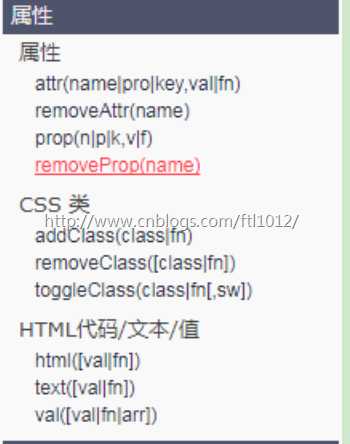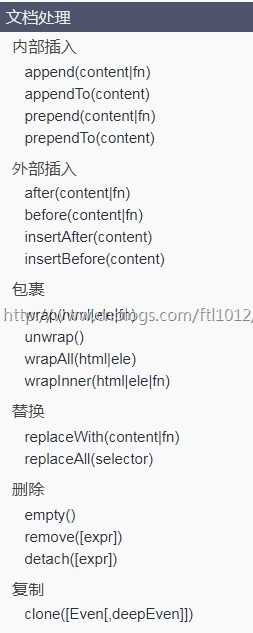JQuery学习---JQuery深入学习
Posted ftl1012
tags:
篇首语:本文由小常识网(cha138.com)小编为大家整理,主要介绍了JQuery学习---JQuery深入学习相关的知识,希望对你有一定的参考价值。
属性操作
$("p").text() $("p").html() $(":checkbox").val()
$(".test").attr("alex") $(".test").attr("alex","sb")
$(".test").attr("checked","checked") $(":checkbox").removeAttr("checked")
$(".test").prop("checked",true)
$(".test").addClass("hide")
<body>
<input id=‘ck‘ type="checkbox" school="peking">
</body>
<script src="jquery-3.2.1.js"></script>
// attr表示自定义的属性,一个参数标书属性,2个参数表示参数和参数值
$("#ck").attr("checked","true"); //添加属性checked
$("#ck").removeAttr("checked"); //取消属性checked 在JQ3中,取消属性不能用attr("checked","false"),必须用remove
// prop表示固有的属性【最适用selected和checked】
$("#ck").prop("checked",true);
$("#ck").prop("checked",false); // 注意这里布尔值不带引号,JQ3中取消属性不能remove,必须使用不带引号的布尔值
</script>
初始值:
用prop修改:自定义属性修改失败,固定属性修改成功[内部有一个Attributes集合,设置成功与否与此有关]
用attr修改[此时id=xxx]:attr都可以进行修改成功[内部有2个状态,true和false,自定义的默认undefied]
总结一下:
JQ3中: attr的取消必须remove; prop的取消使用不带引号的布尔值参数
固有属性[select,checked]用prop; 自定义属性用attr
文档处理
内部插入 $("#c1").append("<b>hello</b>") $("p").appendTo("div")
prepend() prependTo()
外部插入 before() insertBefore() after insertAfter()
replaceWith() remove() empty() clone()
取值操作:
<!DOCTYPE html>
<html lang="en">
<head>
<meta charset="UTF-8">
<script src="jquery-3.2.1.js"></script>
</head>
<body>
<input id=‘ck‘ type="text" value="你好">
<input type="checkbox" name="hobby" value="basketball"> <!-- value默认是on,如果value有则显示本身值-->
</body>
</html>
<script src="jquery-3.2.1.js"></script>
<script>
// 取出value属性
console.log($(":text").val()); //打印:你好,取值操作
$(":text").val("hello world"); //打印:hello world, 此时修改了框内内容
console.log($(":checkbox").val()); //打印:basketball,取值操作
</script>
父子类直接的插入:
<!DOCTYPE html>
<html lang="en">
<head>
<meta charset="UTF-8">
<script src="jquery-3.2.1.js"></script>
</head>
<body>
<div id="div1" style="color: yellowgreen">div1
<p id="p0" style="color: #c233cd">inner_p0</p>
<p id="p2" style="color: #3e40cd">sbulings_p2</p>
</div>
<p id="p1">outer_p1</p>
</body>
</html>
<script src="jquery-3.2.1.js"></script>
<script>
// ------------------------------内部插入------------------------------
// $("#div1").append($("#p1")); // div1 -> inner_p0 -> sbulings_p2 -> outer_p1
// $("#p1").appendTo($("#div1")); // div1 -> inner_p0 -> sbulings_p2 -> outer_p1
// $("#div1").prepend($("#p1")); // outer_p1 -> div1 -> inner_p0 -> sbulings_p2
// $("#p1").prependTo($("#div1")); // outer_p1 -> div1 -> inner_p0 -> sbulings_p2
// ------------------------------外部插入------------------------------
// $("#div1").after($("#p1")); // div1 -> inner_p0 -> sbulings_p2 -> outer_p1
$("#p1").before($("#div1")); // div1 -> inner_p0 -> sbulings_p2 -> outer_p1
</script>
文件操作之删除:
remove(): 删除本标签以及内容
empty() : 仅仅情况了内容,但保留了本标签
jQuery事件绑定补充之委托
$(‘li‘).click(function () {
// 方法一
})
$(‘li‘).on(‘click‘, function () {
// 方法二
})
// 基于Jquery的委托绑定
$(‘td‘).on(‘click‘, ‘.td-delete‘, function () {
$(‘.remove, .shade‘).removeClass(‘hide‘)
})
事件绑定:
【更多参考】http://jquery.cuishifeng.cn/ready.html
1.DOM下操作
2. jQuery操作[去掉了on的onclick()]
DOM下的操作【复习】:
<!DOCTYPE html>
<html lang="en">
<head><meta charset="UTF-8"></head>
<body>
<p id="p1" onclick="func1(this)">hello world 2017</p>
<p id="p2">hello world 2018</p>
</body>
<script>
// DOM绑定事件的复习:方法一
function func1(self) {
var info = self.innerHTML;
alert(info);
}
// DOM绑定事件的复习:方法二
var obj = document.getElementById("p2")
obj.onclick = function () {
alert(this.innerHTML) // 可以直接使用this,调用对象的属性
}
// onload()方法复习
window.onload=function () {
var obj = document.getElementById(‘hello‘);
alert(obj.nodeName)
}
</script>
</html>
jQuery方法复习:实现css样式:
<!DOCTYPE html> <html lang="en"> <head><meta charset="UTF-8"></head> <body> <p id="p1">hello world 2017</p> <p id="p2">hello world 2018</p> </body> <script type="text/javascript" src="jquery-3.2.1.js"></script> <script> $("#p1").css("color","red"); </script> </html>
jQuery下的onload()
取消事件:unload()
<!DOCTYPE html>
<html lang="en">
<head><meta charset="UTF-8">
<script type="text/javascript" src="jquery-3.2.1.js"></script>
<script>
// jQuery下面的onload方法使用一:
$(document).ready(function () {
$("p").css("color","red"); // 给所有的P标签变红
$("#p1").css("color","green"); // p1变绿色
})
// jQuery下面的onload方法使用二【推荐使用,方法一的简写】:
$(function () {
$("p").css("color","orange"); // 给所有的P标签变红
})
</script>
</head>
<body>
<p id="p1">hello world 2017</p>
<p id="p2">hello world 2018</p>
</body>
</html>
jQuery的页面载入
ready(fn)
jQuery的事件绑定: click(), bind(),on()等事件绑定操作
取消事件:off()等;
<!DOCTYPE html>
<html lang="en">
<head><meta charset="UTF-8"></head>
<body>
<p id="p1">hello world 2017</p>
<p id="p2">hello world 2018</p>
<ul>
<li>111</li>
<li>222</li>
<li>333</li>
</ul>
<input type="button" value="+" onclick="add()">
</body>
<script type="text/javascript" src="jquery-3.2.1.js"></script>
<script>
// jQuery下面的onclick():
$("p").click(function () {
alert(123);
})
// jQuery下面的bind()[bind方法不建议使用]:
$("p").bind("click", function () {
alert(456);
})
function add() {
$("ul").append(" <li>444</li>");
}
// 点击li触发一个函数,但是后面新添加就无法实现点击触发的效果了,使用on函数解决
$("ul li").click(function () {
alert("hello world");
})
//jQuery下面的on():on(events,[selector],[data],fn)
// 实现了动态添加的一个事件委托,绑定了ul,但是实现了li的onclick
// $("ul li").on("click" ,function () { 错误的使用,缺少了selector,根bind效果同,无法实现动态绑定效果
$("ul").on("click","li",function () {
alert(‘on‘);
})
function func2(event) {
alert(event.data.foo); // 取值操作
}
$("p").on("click",{foo:‘on的data传值操作‘},func2)
// JQ3多用on, JQ2多用delegated
</script>
</html>
jQuery的回调函数:
<!DOCTYPE html>
<html lang="en">
<head>
<meta charset="UTF-8">
<title>Title</title>
</head>
<body>
<p style="display: none">hello world</p>
<input id="show" type="button" value="显示">
<input id="hide" type="button" value="隐藏">
<input id="toggle" type="button" value="toggle">
<script src="jquery-2.1.4.min.js"></script>
<script>
$("#show").click(function () {
$("p").show(2000,function () {
alert(123)
});
});
$("#hide").click(function () {
$("p").hide(1000);
});
$("#toggle").click(function () {
$("p").toggle(1000);
});
</script>
</body>
</html>
jQuery的扩展方法:
自定义扩展[jQuery调用]
自定义扩展[标签调用]
私有域的扩展[将自定义的函数放入到一个函数内部进行调用,保证内部变量不被外部调用],变量只在函数内部哈~
<!DOCTYPE html>
<html lang="en">
<head>
<meta charset="UTF-8">
</head>
<body>
<p id="p0">hello world 2018</p>
<script src="jquery-2.1.4.min.js"></script>
<script>
// 自定义函数,直接由jQuery调用
$.extend({
getMax:function (a,b) {
alert(a>b?a:b);
}
})
$.getMax(3,8); // 8
// 自定义函数,必须由标签对象调用
$.fn.extend({
print:function () {
alert($(this).html()); // jQuery中查询值
}
});
$("p").print();
// 高级应用 --自定义函数添加私有域,避免内部变量被外部调用,避免变量产生冲突
(function (a) {
alert(a)
})(666) ; // 打印666 // 自执行的匿名函数
(function ($) {
// 扩展的私有方法,添加了私有域
$.fn.extend({
print:function () {
alert($(this).html()); // jQuery中查询值
}
})
})(jQuery); // 不写jQuery也可以,为了方便识别
$("p").print(); // hello world 2018
</script>
</body>
</html>
JQuery中for循环的使用
JQuery中for循环的使用:
1. 数组,键值对的使用
2. 集合的取值
<script src="jquery-3.2.1.js"></script>
<script>
// for循环:数组,Json的Key-Value
li = [1,2,3,4,5,6,7];
kv = {name:"hello", value:"world"};
$.each(kv,function (key, value) {
console.log(key,value);
})
</script>
for循环集合的打印:【注意$符号】
<!DOCTYPE html>
<html lang="en">
<head>
<meta charset="UTF-8">
<title>left_menu</title>
<script src="jquery-3.2.1.js"></script>
</head>
<body>
<ul class="menu">
<li id="c1" class="current" onclick="tab(this);">菜单一</li>
<li id="c2" onclick="tab(this);">菜单二</li>
<li id="c3" onclick="tab(this);">菜单三</li>
</ul>
</body>
<script src="jquery-3.2.1.js"></script>
<script>
$("li").each(function () {
console.log($(this).html()) // ,注意$符号取出内容
})
</script>
</html>以上是关于JQuery学习---JQuery深入学习的主要内容,如果未能解决你的问题,请参考以下文章




